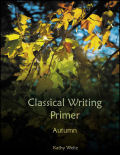The Classical Writing Primer series is a perfect example of the melding of Charlotte Mason methods with classical education. It combines narration, picture study, drawing, nature study, copywork, dictation, spelling, and grammar. Some Charlotte Mason resources for this level lean more heavily only upon the first four strategies while classical educators tend to use dictation and teach more rules as we see in the spelling and grammar exercises in Classical Writing Primer. In spite of this broad coverage, you will still need other resources for sequential teaching of phonics, spelling, and/or handwriting if you need to teach these subjects.
There are three courses in the series, titled Autumn, Winter, and Spring. While courses can be used in any order, they are themed to the corresponding seasons. Using them in the order I have listed will make the most sense for those following a typical school-year calendar.
For each course you need to purchase a student workbook (available only as a printed book) and a Teaching Helps booklet (available only as a PDF ebook). You will also need to download the free Picture booklet for each course through the publisher's website. In addition, within each student workbook is a web link to a resource page for each course where you will find links to sites with pertinent activities or resources. Each course also uses a classic children's book for narration stories. These books can be purchased, but they are also available free online.
Each course should take twelve weeks to complete, so you should plan on using all three courses in one school year. While courses are recommended for grades one through four, they are designed to be used as precursors to Classical Writing: Aesop (also from Classical Writing).
To be ready for the Primer level, students should be able to read sentences and brief paragraphs. They should have already learned to write words (in either manuscript or cursive). They should be able to copy sentences with minimal difficulty. This is likely to be at least first or second grade level for most children. Some children might need to wait until third or even fourth grade. The vocabulary and dictation work within the courses will stretch most young students and might even be too taxing for some. The Teaching Helps books suggest working up to dictation slowly and gradually. For example, a student might take the first sentence of a paragraph by dictation and copy the rest. The Teaching Helps offer other suggestions for adapting exercises.
Each day, students will complete some copywork and a short grammar or phonics exercise that relates to the copywork. Copywork is drawn from works by A.A. Milne, Lucy Maude Montgomery, Beatrix Potter, C.S. Lewis, Rudyard Kipling, and Jean Henri Fabre, as well as from poems, hymns, and the Bible.
Two days a week, you will read a selection directly from the literary work for that course, and children will respond with an oral narration and a drawing. You will present new vocabulary words that will be encountered in the reading before you begin. The literary selections are: The Aesop for Children, illustrated by Milo Winter, for Autumn; Fifty Famous Stories Retold by James Baldwin for Winter; and The Adventures of Danny Meadow Mouse by Thornton Burgess for Spring.
Nature study and picture study each occur one day per week. For nature study, students make observations from their yard or neighborhood, then write about them or make a drawing. Many of the web-linked resources tie in to the nature study topics.
For picture study, you will use the free Picture file, a PDF booklet of major works of art. You may print this out only for your own use, but you might, instead, want to have students view the images on a screen with as high resolution as possible so they can clearly see the details. Each course features a number of paintings, but only the work of two artists for each course: Winslow Homer and Pierre-Auguste Renoir for Autumn, Vincent Van Gogh and Jean-Francois Millet for Winter, and Pieter Bruegel and Mary Cassatt for Spring.
You should become familiar with the Teaching Helps booklet before you begin since notes for each type of activity are presented in separate sections. This is because notes are generally brief and sometimes apply broadly across the course rather than only to specific lessons. You will not need to revisit some of the Teaching Helps sections every week. Answer keys for predictable exercises in the spelling and grammar sections are in the Teaching Helps.
When I first started reviewing Classical Writing Primer, I thought it might prove unwieldy since you have four important components that you will use regularly: the student workbook, Teaching Helps, Pictures, and the children's literature book. However, I came to see that the predictable pattern of the lessons greatly simplifies the process. Also, you will generally be able to look at the Teaching Helps once a week and jot down a few things to remember so you don't need to reference the book very often.
Christian poems and hymns plus scripture passages make these courses suitable for a broad Christian audience.
In summary, I think Classical Writing Primer is likely to please both Charlotte Mason and Classical education fans. It is more rigorous than some Charlotte Mason resources, but it emphasizes the beauty of literature, art, and nature while helping children develop basic skills.
(Read my review of the rest of the Classical Writing courses by clicking here.)








